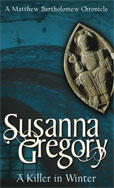 The Ninth Chronicle of Matthew Bartholomew
The Ninth Chronicle of Matthew Bartholomew
Christmas 1354, and in Cambridge the winter is as severe as anyone can remember. But however cold the weather gets, for two individuals it is about to get even colder.
A drunken attempt at blackmail by Norbert Tulyet, an errant scholar who has enrolled in the Franciscan Hostel of Ovyng Hall, leaves him dead on that foundation’s doorstep. And in St Michael’s church, a second unidentified body holds an even greater mystery.
For Matthew Bartholomew, the murders would be difficult to solve at a normal time of year, but now he has a further serious distraction to deal with. Philippa Abigny, to whom he was once betrothed, has returned to Cambridge with the man she left him for, the merchant Sir Walter Turke.
Bartholomew hopes that the couple’s stay will be brief, but he is about to be sorely disappointed. For not only does the mysterious body in church turn out to be Walter’s servant, but events conspire to ensure that Walter will never leave Cambridge again …
Amazon.co.ukKindle EditionWaterstonesEbook
Amazon.comUS Kindle Edition
Extract
Cambridge, December 1354
The church smelled of cheap incense and damp plaster, with an underlying musty odour emanating from an array of ancient vestments that were hanging on a row of hooks near the porch. Michaelhouse’s scholars thought these grimy robes, which were liberally spotted with mould, should be either cleaned or thrown away, but Master Langelee always demurred, claiming that they might come in useful one day. Bartholomew supposed they would fester on their rusty hooks until they turned to dust, since he could not imagine anyone willingly donning the things when there were newer and less odorous ones available.
Harysone was not in the nave, so Bartholomew and Michael walked towards the chancel. Their feet on the flagstones made the only sound. The church comprised the nave and chancel, two aisles and two chapels. The south chapel was usually called the Stanton Chapel, named for Michaelhouse’s founder who was buried there. It was one of the finest examples of modern architecture in Cambridge, but the chancel was the building’s crowning glory. It was larger than the nave, and boasted simple, but elegant, tracery in its arched windows, while its walls were painted with scenes from the Bible in brilliant reds, blues, yellows and greens. When the sun shone, light pooled in delicate patterns on the creamy-white of the floor, although that day the whole building was gloomy.
Bartholomew noticed that one of the candles on the high altar had wilted, and that wax was dripping on the floor. He went to straighten it and scrape away the mess with a knife, while Michael gazed around in agitation.
‘That damned pardoner Harysone is not here!’ he muttered angrily.
Bartholomew shrugged as he worked. ‘We were at least an hour – probably longer – with Norbert’s body. I am not surprised that your quarry has left.’
Michael was disgusted. ‘Now we shall never know what he was doing.’
‘Meadowman said he may not have come in here at all. Perhaps he gave up on the latch and left. Or perhaps he exited through the south door.’
‘Why would he do that?’ called Michael testily, prowling around the Stanton Chapel, as though Harysone might be hiding behind the founder’s tomb.
‘Because the latch jammed and he found himself unable to leave through the north one?’ suggested Bartholomew, giving the pewter candleholder a quick polish on his sleeve.
‘You are right!’ exclaimed Michael triumphantly, when he went to inspect the little-used exit in the south aisle. It was larger than the north door, but Master Langelee believed that using the smaller entrance kept the building warmer. The south aisle was occasionally employed as a mortuary chapel for parishioners, but most of the time it stood empty and unused. ‘Someone has been out this way.’
The door had been left ajar, and the monk opened it fully to peer out, before shutting it again. A stout bar prevented anyone from entering from the outside, and he studied it thoughtfully before replacing it in its two metal clasps. Bartholomew pointed out that anyone might have opened it, and that it did not necessarily imply some wrongdoing on Harysone’s part. Michael listened patiently, but clearly did not agree. Seeing neither was going to accept the other’s point of view, they abandoned the discussion and headed to the north door. As Bartholomew jiggled the latch, the monk forgot his tirade against Harysone to wrinkle his nose and indicate the row of robes that hung nearby.
‘The stench of those things is growing stronger by the day. They are too rotten ever to use again, and I cannot imagine why Langelee does not throw them away.’
‘Langelee never throws anything away if he thinks it may be useful. Michaelhouse is not wealthy, and he is just being prudent, I suppose. Shoes.’
‘What are you talking about?’ asked Michael, confused.
‘Shoes,’ repeated Bartholomew, pointing at the robes. ‘I think someone is hiding from you.’
Michael followed the line of the physician’s outstretched finger and his lips compressed in grim satisfaction. Poking from under the untidy, bulky folds of material was a pair of scruffy leather shoes. Someone had evidently slipped in among the albs and chasubles in the hope that he would be hidden – as he would have been, had he not left his feet in full view. Michael marched across to the line of hooks, and ripped the gowns aside.
The face that looked back at him was not Harysone’s, however. Nor was it the face of a living man. It was a corpse, with a pallid blue tinge about its mouth and lips, and unseeing eyes that were half open, half closed.

